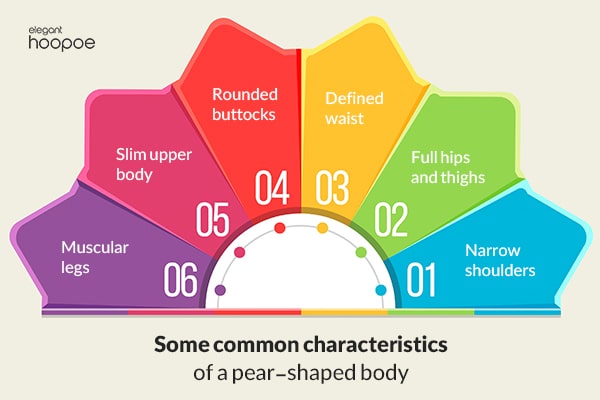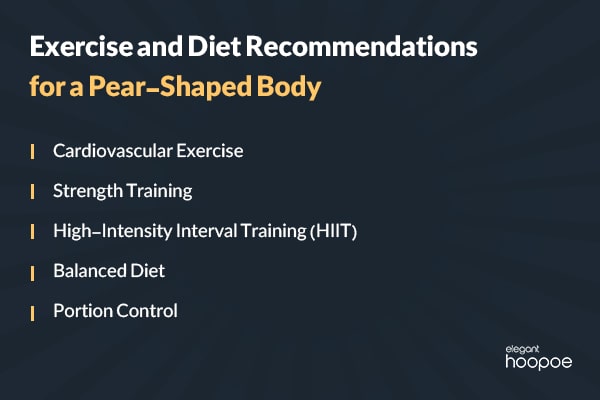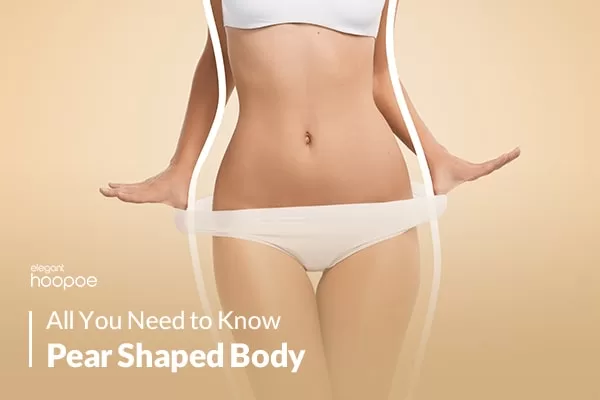A pear-shaped body is also known as a triangle shape, where the lower part of the body is larger than the upper part. People with pear-shaped bodies tend to carry more weight in their lower abdomen, hips, and thighs. While this body type can be beautiful and healthy, some people may wish to alter their body shape by losing weight in certain areas, such as stubborn lower belly fat.
Many people think that the secret of good looks lies in having a beautiful body and choosing beautiful clothes. While this notion is completely false. Being good-looking depends on many factors! One of the most important of them is knowing the correct “body shape” and wearing clothes that balance the upper and lower body according to it. Accordingly, we have four types of organs:
- Pear shaped.
- apple-shaped.
- Hourglass.
- inverted triangle
The most ideal body shape is the hourglass shape. These people have no restrictions on their dressing. In this article on elegant hoopoe, we will explore the pear-shaped body, its causes, characteristics, health risks associated with a pear-shaped body, fashion tips and suitable styles, exercise and diet recommendations, and more.
Definition of a Pear-Shaped Body
what is a pear-shaped body?
the expression refers to a body type where the hips and thighs are wider compared to the shoulders, bust, and chest. This body shape is characterized by carrying excess weight in the lower half of the body, while the upper half is relatively slimmer. The pear-shaped body is also known as the triangle body shape, where the hips and thighs are the widest part of the body, and the waist and bust are smaller in proportion.
Over the years, one of the most common questions I’ve been asked is, ” how to lose love handles or muffin tops. It seems to be a problem that almost everyone – man and woman – is dealing with. In fact, I’ve never met anyone who “likes” excess fat that sits at the sides of their waist.

Characteristics of pear body shape
A pear-shaped body is characterized by wider hips, thighs, and buttocks compared to the upper body. The main characteristic of a pear-shaped body is the large hips, which are wider than the chest and shoulders. Some common characteristics of a pear-shaped body include:
- Narrow shoulders: The arms and shoulders are narrow but well proportioned; The shoulders tend to be narrower than the hips, creating an inverted triangle shape.
- Full hips and thighs: The width of the shoulders is less than the width of the hips and may be slightly sloping; The hips and thighs are typically wider than the waist and upper body, giving the lower half of the body a fuller appearance.
- Defined waist: The shape of the waist cavity is clear; The waist is usually well-defined, creating an hourglass shape when viewed from the front.
- Rounded buttocks: The hips and thighs are plump; The buttocks are often round and full, with a more pronounced curve than in other body types.
- Slim upper body: The upper body is smaller than the lower body; The upper body is usually slimmer in comparison to the lower body, with a smaller bust and narrower shoulders.
- Muscular legs: The legs are most likely muscular; Weight gain can be seen in the hips, thighs, and lower body.
These characteristics can vary in degree and may be influenced by factors such as genetics, hormones, and lifestyle habits.

Does the Distribution of Body Fat Depend on Genetics?
Numerous factors influence fat distribution, with genetics being the primary determinant. It is valid for both sexes but affects women more often than men. Men have been found to have more fat in specific areas of their bodies, such as the abdomen, which may account for or are associated with a higher rate of cardiovascular problems in this population. Though it can seem frustrating, women’s propensity to accumulate fat in places like their legs or hips may shield them from this type of illness.
Related service:
Non-surgical cellulite removal
how to lose love handles
Your Body Shape Is a Product of Your DNA
Most issues, if not all of them, are influenced by our genetic makeup, including our appearance and potential health issues. Body type is also included in this. Genetic differences influence the waist-to-hip ratio. This finding might make it possible to conduct additional research on these variations, which could assist in determining possible illnesses or ailments like obesity and treating them before they have a chance to worsen.
Health Concerns of a Pear Body Shape
The Pear Body type presents difficulty due to conflicting and contradictory findings from research on this particular body type. According to earlier research, having fat in regions like the thighs, buttocks, and hips reduces the possibility of heart attack and stroke. Excessive fat accumulation in these areas can result in health issues such as joint problems and diabetes. Any form of weight loss contributes to reduced cholesterol levels, improving overall heart health.
Pear Body Type: Actions to Take
Losing weight is an endeavor that calls for dedication and self-control. Results can be obtained through a balanced combination of physical activity and a nutritious diet; one helpful strategy is to eat fewer portions. However, one must remember that the body requires energy to function, so obtaining the proper quantity is just as crucial, if not more so.
Related article: smart lipo vs airsculpt
What Leads To Unresponsive Fat Deposits?
Persistent fat accumulation can build up for a variety of reasons and through a variety of bodily processes. They are frequently stubborn to diet and exercise. The following list of causes for the development of persistent fat in specific areas:
1. Genetics
Genetic traits largely determine the location of fat storage in the body. Certain people have a genetic predisposition to store fat in particular places, making it challenging to lose weight using traditional methods. It is because genes influence factors such as metabolism, hormone levels, and the structure of fat cells, all of which can affect how and where fat is stored in the body.
2. Hormonal
Elements Changes in hormones can affect the allocation of fat. Hormonal imbalances, such as altered testosterone and estrogen levels or elevated cortisol from stress, may be responsible for localized fat deposition.
3. Age
People’s metabolisms may fade down as they get older, which can cause variations in the distribution of fat. Particular areas of the body keep fat more readily than others due to hormonal changes and metabolic rate changes brought on by aging.
4. Lifestyle
Poor eating habits, inactivity, and sedentary lifestyles can all lead to fat buildup. Habits like overeating sugar or consuming fats can accumulate fat in specific areas.
5. Disparities in Gender
The way that men and women keep fat varies. Because of hormonal distinctions, men can build up more fat surrounding the abdomen (central obesity), while women can hold fat in the buttocks, thighs, and hips.
6. Pressure
Prolonged stress can affect cortisol levels, which can result in the buildup of belly fat. Gaining weight in particular areas can also be attributed to diets or behaviors caused by stress.
7. Chemical Components
Certain people are more susceptible to metabolic disorders that impact their ability to store fat. Particular circumstances, such as metabolic syndrome or insulin resistance, can cause fat to grow more rapidly in specific body areas.
8. Basic Fat Spread
No matter a person’s attempts to reduce weight, the body inherently stores fat in particular places. These can differ from individual to individual and are frequently challenging to reduce with only physical activity and a healthy diet. A number of physiological, hormonal, lifestyle, and genetic aspects can contribute to obstinate fat accumulation. Even though a balanced diet and consistent physical activity are proven to remove body fat in general, some areas may not respond to these attempts, requiring plastic surgery like liposuction to target particular localized fat stores. Contact Hoopoe if you’re looking for laser liposuction in Dubai Contact Hoopoe if you’re looking for laser liposuction in Dubai.

Exercise and Diet Recommendations for a Pear-Shaped Body
If you have a pear-shaped body, you may struggle with excess fat around your hips, thighs, and buttocks. While you cannot change your body shape, you can make healthy lifestyle choices that help you feel confident and improve your overall health. Here are some exercise and diet recommendations for a pear-shaped body:
- Cardiovascular Exercise: Cardiovascular exercises, such as running, cycling, or swimming, can help you burn calories and reduce overall body fat. Aim for at least 30 minutes of moderate-intensity cardio exercise most days of the week.
- Strength Training: Strength training can help you build muscle and boost your metabolism. Focus on exercises that target your lower body, such as lunges, squats, and leg presses.
- High-Intensity Interval Training (HIIT): HIIT workouts combine short bursts of intense exercise with rest periods. This type of workout can help you burn more calories in less time than steady-state cardio.
- Balanced Diet: Eating a balanced diet that includes plenty of fruits, vegetables, lean protein, and whole grains can help you maintain a healthy weight. Limit your intake of processed foods, sugary drinks, and high-fat foods.
- Portion Control: Pay attention to portion sizes when you eat. Use smaller plates and measure your food to avoid overeating.
Remember that a healthy lifestyle is about more than just your body shape. Focus on making choices that make you feel good and support your overall health and well-being.
Related article: laser lipo side effects
Options for Plastic Surgery on Pear Body Shapes
Although pear-shaped bodies tend to store fat in the thighs and hips due to thigh structure, they can be attractive and seductive if kept fit and slim. Diet and exercise alone won’t eliminate this excess fat accumulation.
To further improve your outcomes, you should combine these body-shaping treatments with additional surgical options. For instance, liposuction or a stomach tuck to tighten the waist and breast augmentation to improve the upper body may be beneficial for pear-shaped patients who aspire to an hourglass figure. These therapies can be used in isolation or in conjunction with other surgical procedures.
It’s a collaborative effort to determine the best methods for your body type. Plastic surgeons can offer suggestions to enhance particular body parts. Together, you and they will identify options that align with your desired look, way of life, and lifestyle. Thanks to the availability of surgical and nonsurgical treatments, experts can determine a workable option for most patients. Are you prepared to form the best possible shape for your body type? Make an appointment for a consultation to learn more about body carving.







